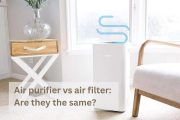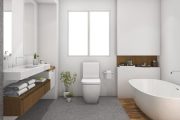On the market, there are two sorts of air purifiers: large, boxy machines that can clean a whole room at once and compact units that can be placed on your desk or kitchen table and run all day. While these air purifiers may remove a significant quantity of allergens from your home’s air, they do not need to operate continuously to be effective.
So, if you are considering getting an air purifier for your home, you may also be wondering whether to purchase a couple of smaller ones for different areas of the house instead of a big one to ensure clean air throughout. But you may also say to yourself, “Wouldn’t it be easier to change one air filter rather than several?”
The decision between a single, larger air purifier with higher airflow and two smaller air purifiers is influenced by where the air purifier will be used.
Note: If you need answers to common questions about air purifiers, please read our air purifier FAQs.
Related posts
Can one air purifier clean an entire house?
Yes, a big air purifier, also known as an air cleaner, may function in numerous rooms if your rooms are fairly open to one another. The essential thing to remember is that one huge unit will take longer, and you will need to run it for longer and at maximum speed.
A huge air purifier will not clean the air in other rooms if one of the rooms has closed doors. If the door is left open, the air will flow into the adjacent room and finally into the air cleaner. The size of the air cleaner and the number of air changes per hour are two elements that influence how quickly the air is cleaned. The size of an air purifier is measured in CFM (cubic foot per minute) of air sucked into the purifier; the more circulation you have, the faster it will draw air from the next room.
Furthermore, when particles in the air space are decreased, those that remain will similarly space themselves apart by dispersion, eventually working their way to the other side of the air space. The air purifier’s air movement will minimize the number of particulates, bringing the remaining particles closer to the air cleaner. This procedure allows the air on the other side of the room to be cleansed. You should run your air purifier 24/7 to get rid of new particulates from your pets, air conditioner, open windows, or even from you.
Furthermore, improved circulation through the use of fans improves the cleaning process in a broad area or numerous open rooms. If you have a fan sucking air from another room, it will be easier to attract this air into the air purifier to be cleansed.
It’s also smart if you are considering one air purifier for your entire house to obtain a combination HEPA and carbon-filtered air purifier, since these machines can remove a wide range of particles, gases, and smells from your house air.
Is a bigger air purifier better?
Whether a bigger air purifier is better or not mostly depends on your room’s size and your budget. A filter with a large surface area may produce significantly greater airflow, eliminating all undesired particles from the air in a single cycle, providing a better filtration rate and eventually cleaner air, which will be especially advantageous in bigger spaces. However, a bigger air purifier will be more costly to acquire and also consume more electricity to operate. So, if you have a small room, a big air purifier may not be necessary.
List of the best air purifiers
- 1, Best Air Purifier (Air Purifier Ranking List)
- 2, Best Air Purifiers for Allergies
- 3, Best Air Purifiers for Bedroom
- 4, Best Air Purifiers for Baby
- 5, Best Air Purifiers for Smoke
- 6, Best Air Purifiers for Dust
- 7, Best Air Purifiers for Mold
- 8, Best Large Room Air Purifiers
- 9, Best Air Purifiers for Pets
- 10, Best Air Purifiers for Office
The key factor is the number of air changes per hour (ACH). To calculate the ACH, take the volume of the air space and divide it by the volume of air cleaned by the unit in an hour.
For instance, if your room is 125 square feet with an 8-foot ceiling, the volume is 1000 cubic feet. If you consider an air cleaner with 100 CFM and 6 air changes, it will clean 6000 cubic feet per hour, which should be enough.
Acceptable air changes per hour will range between 2 and 6. When measuring your space for the correct size unit, two to four air exchanges is a decent rule of thumb to follow.
Can you have multiple air purifiers running together in the same room?
You certainly can. Having two or more air purifiers running together will target pollutants in different areas more efficiently. The only thing to remember is that each air purifier is designed to cover a maximum amount of square footage.Hence, putting two units that are too strong in one room may help purify the room faster, but it is likely a waste of money.
Also, if you intend to use more than one air purifier in one room, make sure their filtration technologies are different or they have one or more unique filtration processes.
Should I get one large air purifier or two smaller ones?
When deciding between one bigger air purifier and two smaller ones, think about the following:
- Noise level: If you are sensitive to noise, a single bigger air purifier will usually have a lower noise level. You should compare the specs of the two air purifiers before acquiring one.
- Air circulation: If your space has poor air circulation or has a complicated form (such as a L shape or a long thin shape), many smaller air purifiers may help enhance ventilation. Two air purifiers positioned in various areas of your room may aid in improving air circulation.
- HEPA filter life expectancy: Larger air purifiers may have larger HEPA filters that last longer. The Rabbit Air MinusA2, for example, has a huge HEPA filter that lasts up to 2 years, whilst the smaller air purifier has a HEPA filter that lasts 6 months.
RATING BREATHE QUALITY
-
Average ratings for this post



